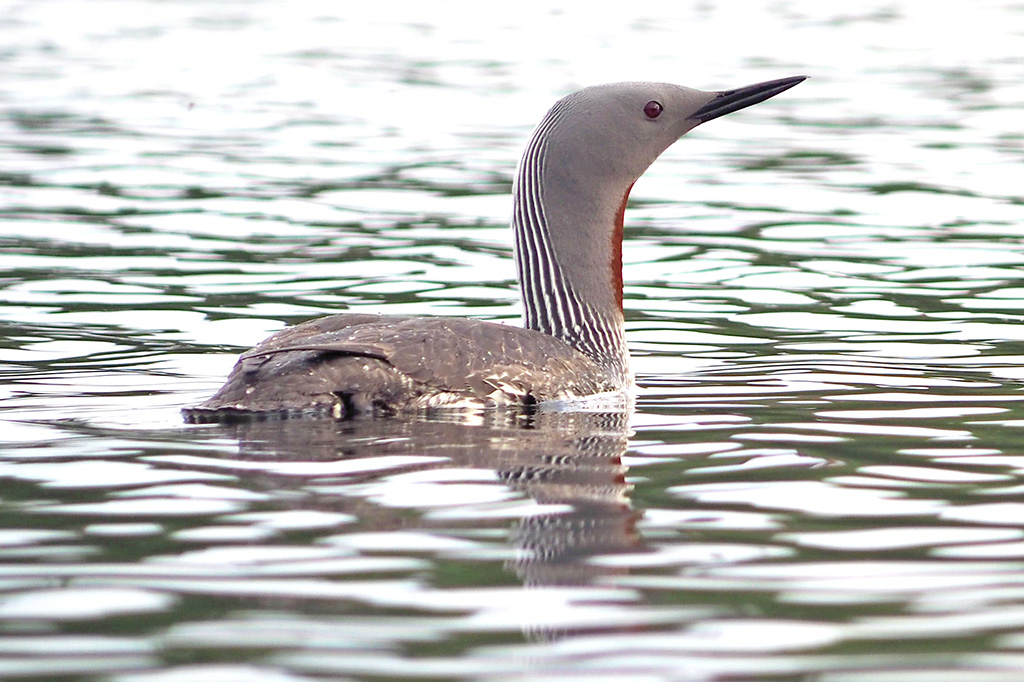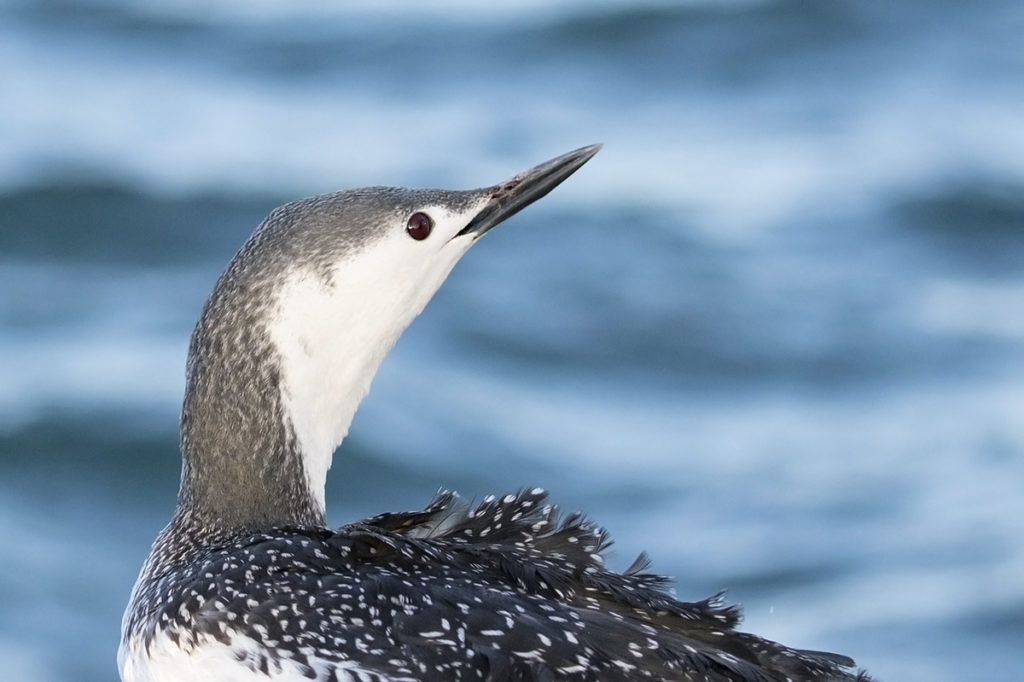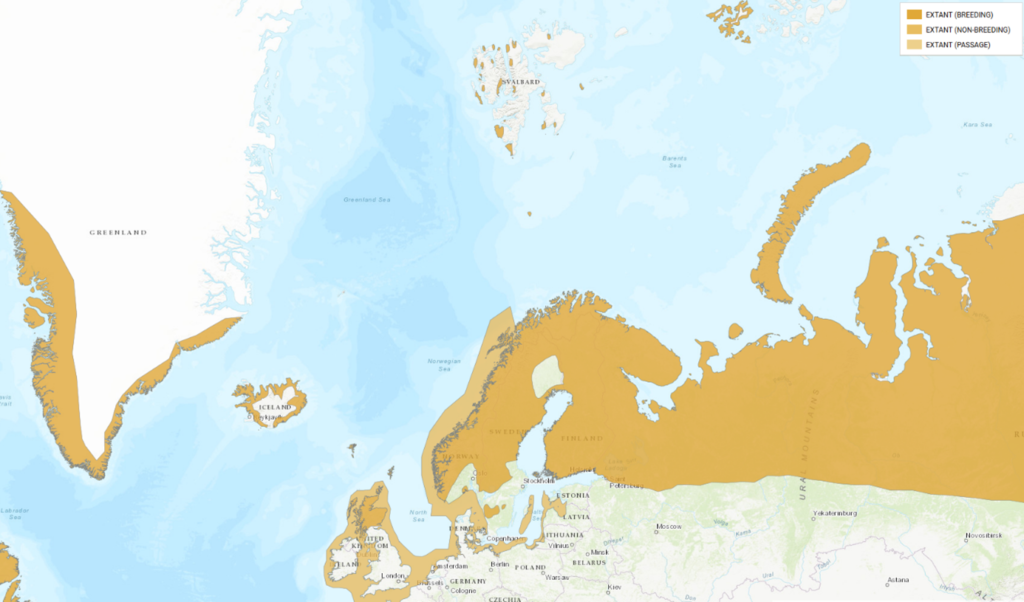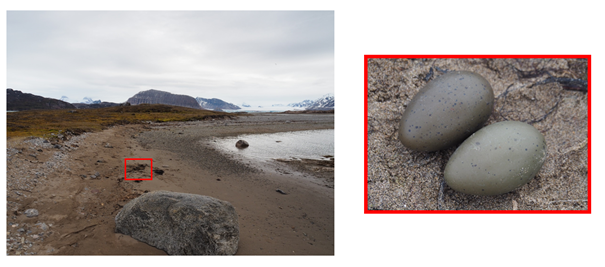About red-throated divers
What do they look like?
Of the four diver species, the red-throated diver (Gavia stellata) is the smallest and lightest with a length of only 53-69 cm and a weight ranging between 1.2-1.9 kg. The species has a flat forehead, a slender figure and the beak is dark and usually held pointing slightly upwards, even in flight.
The red-throated diver is recognised for its distinctive triangular red-brown patch on the throat during the summer which may look black at a distance while the neck and head are grey with white and black stripes on the backside of the head. The scientific species name stellata means ‘with a star’ which is reflected in the German species name ‘Sterntaucher’.

The winter plumage is lighter than the summer plumage and the bird appears grey/brown. Much of the face and neck is white and the mantle is black with white speckles. Juvenile birds look similar to the adults in winter but are less white in the face and around the neck.

Where can we find them?
The red-throated diver has a circumpolar breeding distribution in the Arctic and boreal zone and can be found in North-America, Greenland, Iceland, Scandinavia, Svalbard and Russia. As migrants and winter guests, red- throated divers can be sighted in Central Europe from autumn until spring when they overwinter in coastal waters, including the German North and Baltic Sea1.

How many are there?
The global population ranges between 200.000-590.000 individuals with 32.000-92.000 breeding pairs in Europe. Of the two diver species that most commonly occur in German waters, red-throated divers are more frequent than black-throated divers (Gavia arctica)2. There are an estimated 16.600 divers in the German North Sea during spring.
The main distribution area of red-throated divers in the German North Sea is located in the German Exclusive Economic Zone (EEZ) west of the North Frisian islands and within the Special Protected Area (SPA) ‘Östlich Deutsche Bucht’ where red-throated divers occur in large numbers in spring and winter3.
Where do they breed?
The species nests solitary on small islands – and sometimes tiny islets – primarily in coastal tundra, on freshwater lakes and lagoons in the high Arctic.
The nest of red-throated divers, which is often only a platform of mud and vegetation, is maybe not the most beautiful, but is strategically well positioned just a few steps away from the water so that the incubating parent can relatively easily reach the water when it is disturbed by intruders. This is especially important as the birds walk rather clumsy in an awkward manner on land because their legs are very back on the body.

The eggs of red-throated divers (usually 2 eggs but clutch sizes can range between 1-3 eggs) are olive-brownish with black spots and therefore well-camouflaged on the brownish ground of the tundra. Both parents incubate the eggs for 24-29 days before the chicks hatch, which are uniform grey-brown in colour and spend most of the time swimming before they fledge after around 4-6 weeks.


Foraging & food
Red-throated divers feed on different marine and freshwater fish species, which are caught when diving. The most important prey species include Common Cod, different Goby species, Atlantic herring and sticklebacks4. To catch their prey, they mostly undertake shallow dives with maximum depths of 20 m in summer5. There is no precise data on foraging behaviour in the wintering areas of the North and Baltic Sea.

- 1.Mendel B, Sonntag N, Wahl J, et al. Artensteckbriefe von See- Und Wasservögeln Der Deutschen Nord- Und Ostsee: Verbreitung, Ökologie Und Empfindlichkeiten Gegenüber Eingriffen in Ihrem Marinen Lebensraum. 2. Bundesamt für Naturschutz; 2022.
- 2.Vilela R, Burger C, Diederichs A, et al. Use of an INLA Latent Gaussian Modeling Approach to Assess Bird Population Changes Due to the Development of Offshore Wind Farms. Front Mar Sci. Published online July 8, 2021. doi:10.3389/fmars.2021.701332
- 3.Garthe S, Müller S, Schwemmer H, Markones N, Schwemmer P. Verbreitung, Jahresdynamik und Bestandsentwicklung der Seetaucher Gavia spec. in der Deutschen Bucht (Nordsee). Vogelwarte – Zeitschrift für Vogelkunde. 2015;53:121-138.
- 4.Kleinschmidt B, Burger C, Dorsch M, et al. The diet of red-throated divers (Gavia stellata) overwintering in the German Bight (North Sea) analysed using molecular diagnostics. Mar Biol. Published online May 16, 2019. doi:10.1007/s00227-019-3523-3
- 5.Duckworth J, O’Brien S, Väisänen R, et al. First biologging record of a foraging Red-Throated Loon Gavia stellata shows shallow and efficient diving in freshwater environments. Marine Ornithology. 2020;48:17-22.